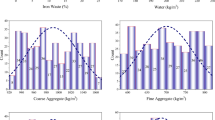Abstract
In the domain of construction engineering, the compressive strength of concrete stands as a critical parameter of immense significance. Nevertheless, the traditional concrete production entails significant physical labor and the consumption of finite natural resources. Furthermore, achieving the requisite compressive strength necessitates a prolonged curing period of up to 365 days. To mitigate these challenges, curtail cement consumption, and address production issues, diverse industrial and agricultural waste materials have been integrated into concrete formulations.
To surmount these limitations, the application of machine learning (ML) has garnered substantial attention in contemporary settings for predicting essential output parameters. This research centers on predicting the compressive strength of red mud (RM) based concrete through the deployment of five distinct machine learning (ML) models, encompassing 14 input parameters, utilizing a dataset of 400 data points. Comparative analysis of the model outputs has been conducted employing a plethora of analytical techniques, such as visual descriptive statistics, error evaluation, scatter plots, R2 coefficient, feature importance (FI), and Taylor's diagram. From a comprehensive evaluation of the study's findings, it was deduced that the decision tree (DT) and extra tree (ET) models exhibited the most favorable fit. This deduction was based on their minimal error rates and higher R2 values when compared to other utilized models.
Microstructural analysis and leaching tests were carried out, attesting to the adherence of red mud-incorporated concrete to safety and toxicity standards. In conclusion, the amalgamation of red mud into concrete formulations holds substantial potential for the development of eco-friendly construction materials and sustainable waste management, especially suited for low traffic or rural road construction applications.













Similar content being viewed by others
References
Ahmad, A., Ostrowski, K. A., Maślak, M., Farooq, F., Mehmood, I., & Nafees, A. (2021). Comparative study of supervised machine learning algorithms for predicting the compressive strength of concrete at high temperature. Materials (basel), 2021, 14. https://doi.org/10.3390/ma14154222
Asteris, P. G., Skentou, A. D., Bardhan, A., Samui, P., & Pilakoutas, K. (2021). Predicting concrete compressive strength using hybrid ensembling of surrogate machine learning models. Cement Concrete Res., 2021(145), 106449. https://doi.org/10.1016/j.cemconres.2021.106449
Chengju, G. (1989). Maturity of concrete: method for predicting early-stage strength. ACI Materials Journal. https://doi.org/10.14359/2099
John, S. K., Nadir, Y., & Girija, K. (2021). Effect of source materials, additives on the mechanical properties and durability of flyash and flyash-slag geopolymer mortar: a review. Construction and Building Materials., 280, 122443. https://doi.org/10.1016/j.conbuildmat.2021.122443
Kaveh, A., & Khalegi, H. (2000). Prediction of strength for concrete specimens using artificial neural networks. Asian Journal of Civil Engineering, 2, 1–13.
Kaveh, A., & Khavaninzadeh, N. (2023). Efficient training of two ANNs using four meta-heuristic algorithms for predicting the FRP strength. Structures, 52, 256–272.
Kaveh, A., & Servati, H. (2001). Design of double layer grids using backpropagation neural networks. Computers & Structures, 79, 1561–1568.
Kumar, R., et al. (2022). Influence of chloride and sulfate solution on the long-term durability of modified rubberized concrete. Journal of Applied Polymer Science. https://doi.org/10.1002/app.52880
Kursuncu, B., Gencel, O., Yavuz, O., & Shi, J. (2022). Optimization of foam concrete characteristics using response surface methodology and artificial neural networks. Const Build Mater., 337, 127575. https://doi.org/10.1016/j.conbuildmat.2022.127575
Lee, S. C. (2003). Prediction of concrete strength using artificial neural networks. Engineering Structures, 25(7), 849–857. https://doi.org/10.1016/S0141-0296(03)00004-X
Naser, A. H., Badr, A. H., Henedy, S. N., Ostrowski, K. A., & Imran, H. (2022). Application of multivariate adaptive regression splines (MARS) approach in prediction of compressive strength of eco-friendly concrete. Case Studies in Construction Material, 2022(17), e01262. https://doi.org/10.1016/j.cscm.2022.e01262
Naenudon, S., Wongsa, A., Ekprasert, J., Sata, V., & Chindaprasirt, P. (2023). Enhancing the properties of fly ash-based geopolymer concrete using recycled aggregate from waste ceramic electrical insulator. Journal of Building Engineering, 68, 10613. https://doi.org/10.1016/j.jobe.2023.106132
Oluokun, F. A., Harold Deatheridge, J., & Burdette, E. G. (1990). Early-age concrete strength prediction by maturity—another look. ACI Materials Journal. https://doi.org/10.14359/2519
Panda, B., & Tan, M. J. (2018). Experimental study on mix proportion and fresh properties of fly ash based geopolymer for 3D concrete printing. Ceramics International, 44(9), 10258–10265. https://doi.org/10.1016/j.ceramint.2018.03.031
Pandey, M., Jamei, M., Ahmadianfar, I., Karbasi, M., Lodhi, A. S., & Chu, X. (2021). Assessment of scouring around submerged spur dike in cohesive sediment mixtures: a comparative study on three rigorous machine learning models. Journal Hydrol, 2021, 127330. https://doi.org/10.1016/j.jhydrol.2021.127330
Popovics, S. (1998). History of a mathematical model for strength development of Portland cement concrete. Aci Materials Journal, 95, 593–600.
Snell, L. M., van Roekel, J., & Wallace, N. D. (1989). Predicting early concrete strength. Concrete International, 11, 43–47.
Vadel, M., Khadija, B., Nawal, Z., & Mohamed, S. (2019). Modeling compressive strength of Moroccan fly ash phosphogypsum geopolymer bricks. SN Applied Sciences., 1(12), 1–9. https://doi.org/10.1007/s42452-019-1736
Van Dao, D., et al. (2019). Artificial intelligence approaches for prediction of compressive strength of geopolymer concrete. Materials. https://doi.org/10.3390/ma12060983
Yunsheng, Z., & Wei, S. (2006). Fly ash based geopolymer concrete. Indian Concrete Journal, 80(1), 20–24. https://doi.org/10.1080/13287982.2005.11464946
Zhang, X., Akber, M. Z., & Zheng, W. (2021). Prediction of seven-day compressive strength of field concrete. Construction and Building Material, 2021(305), 124604. https://doi.org/10.1016/j.conbuildmat.2021.124604
Funding
The authors have not disclosed any funding.
Author information
Authors and Affiliations
Contributions
SS: software. SB: methodology, investigation. VS: writing—original draft. AS: writing—review and editing. AK: writing—review and editing. SNS: writing—review and editing.
Corresponding author
Ethics declarations
Conflict of interest
The authors have not disclosed any conflict of interest.
Additional information
Publisher's Note
Springer Nature remains neutral with regard to jurisdictional claims in published maps and institutional affiliations.
Rights and permissions
Springer Nature or its licensor (e.g. a society or other partner) holds exclusive rights to this article under a publishing agreement with the author(s) or other rightsholder(s); author self-archiving of the accepted manuscript version of this article is solely governed by the terms of such publishing agreement and applicable law.
About this article
Cite this article
Singh, S., Bano, S., Singh, V. et al. An investigative inquiry into harnessing the capabilities of machine learning for the assessment of compressive strength in red mud-based concrete enriched with fly ash as a viable road construction constituent. Asian J Civ Eng 25, 1571–1585 (2024). https://doi.org/10.1007/s42107-023-00862-4
Received:
Accepted:
Published:
Issue Date:
DOI: https://doi.org/10.1007/s42107-023-00862-4




